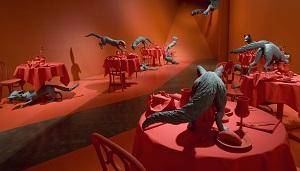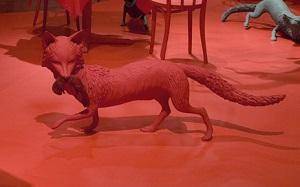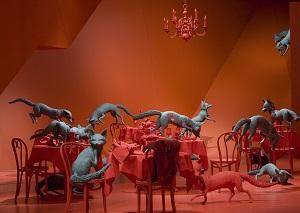Students will use available technology to alter an image of something ordinary and mundane and turn it into a dreamlike fantasy image.
Students will be able to:
- analyze formal and sensory qualities in a work of art;
- use planning to support the development of intended meaning in a work of art;
- collaboratively create a work of art using technological media;
- explain a viewer’s response to familiar and unfamiliar in a work of art;
- sequence ideas logically to support a theme;
- research and experiment with new processes; and
- connect descriptive wording to events and images.
Lesson
Day 1
- Show student the image of Sandy Skoglund’s Fox Games. Have the students list what they can see in the image. Share information from About the Art. Using images from the "Details" section, point out details the students may not have noticed. Lead students in a discussion about how Skoglund likes to create artworks with ordinary spaces viewers think they know and then turn the artworks into dreamlike fantasies. Ask students to identify how she did that with this image.
- Point out how the artist uses bold color and repetition in the image. Skoglund says that she likes to interfere with reality so that the viewers have to make sense out of what they are seeing. Ask students to discuss what descriptive word they would use to describe the image. Would it be “exciting,” “chaotic,” “confusing,” “calm,” or “serene?” Would they use more than one descriptive word?
- If possible, show students other images of Skoglund’s work. Ask for words that describe some of her other works of art. What action, colors, or other elements lead students to choose these words?
- Divide students into small groups and explain that they are going to create an image that takes the viewer from something ordinary to a dreamlike fantasy, in the style of Fox Games. Rather than setting up an installation, students will use technology to alter a photographic image, creating a similar effect to Skoglund’s work. Students will start by deciding on a descriptive word such as “peaceful,” “frenzied,” “hectic,” etc. Then students will brainstorm how they could create such an effect with what is available in the classroom. Remind students that they can and should alter reality to help produce this effect. Creating a rough sketch or two of possible ideas might help the group. If the school has no access to technology, the students could turn these sketches into finished works of art, perhaps collaged together with sketches from the other members of their group.
Day 2
- Ask groups to arrange their chosen scene using things in the room in the way that they planned. Provide them with cameras to take a photo of their scene. (Most art rooms have access to some type of camera. If yours does not, the school’s technology liaison should be able to provide access. Another alternative is to use cell phone or iPod cameras.)
- Download the images into photo editing software, such as iPhoto or even Microsoft Paint applications. You could also use of any of the many free web-based applications, such as Fotoflexer, BeFunky, iPiccy, or Pixlr—there are several that do not require any sort of download.
- Students will alter the photo to fit their descriptive word by changing colors or erasing items, or using whatever filter is available with the software or freeware you are using. Encourage experimentation and play; this is a proven way to learn while having fun and opens up lots of options for 21st century technology use.
- Once the group decides that their image elicits the description they were looking for, they will save the image. It might be a good idea to save versions of the image throughout the exploration process. If a color printer is available, students can print their images. If not, have the class walk around to each computer screen to see the creations. Using details in their image to back up their answers, students will point out details that reflect their descriptive word.
Materials
- About the Art section on Sandy Skoglund’s Fox Games
- Color copies of Fox Games for students to share, or the ability to project the image onto a wall or screen
- Access to random items and furniture around the room
- Sketch paper
- Writing and drawing implements
- One camera (digital, cell phone, or iPod cameras) for each group of 4 or 5 students
- Ability to transfer pictures to a computer
- Photo editing software such as iPhoto, Microsoft Paint, Adobe Photoshop, Picasa, etc.; or web-based freeware such as Fotoflexer, BeFunky, iPiccy, Pixlr, etc.
- A color printer, if available
Standards
- Visual Arts
- Invent and Discover to Create
- Observe and Learn to Comprehend
- Relate and Connect to Transfer
- Envision and Critique to Reflect
- Language Arts
- Oral Expression and Listening
- Research and Reasoning
- Writing and Composition
- Collaboration
- Critical Thinking & Reasoning
- Information Literacy
- Invention
- Self-Direction

Fox Games
- Sandy Skoglund, American, 1946-
- Born: Weymouth, MA
- Work Locations: New York, NY
Sandy Skoglund attended Smith College in Massachusetts and graduate school at the University of Iowa. She was interested in a variety of artistic disciplines and studied filmmaking, printmaking, and multimedia art. Skoglund moved to New York City in 1972 and developed an interest in photography as a way to document her large-scale pieces. Skoglund’s combination of interests is demonstrated in the hybrid of elements she uses to create her pieces, which are usually elaborate and immersive installations of imaginary, sometimes outlandish scenes. She uses aspects of theater to set the stage and cast of characters, sculpture to create interesting spaces, and paint to add bold color. Skoglund says, “If I had to say anything about my work, I think it would be that it’s almost a theme park. You can experience it in many ways.”
With much of her work, the final product has been a photograph of a meticulously staged installation rather than the actual installation itself. But Fox Games is the installation itself. The Denver Art Museum was the first museum to acquire the installation in addition to the photograph of the installation.
In Fox Games, viewers are physically immersed in the work of art as they are able to wander through the installation. “I use familiar spaces… and elements like furniture to take viewers out of the museum and place them in… a place that feels familiar to them. Then I interfere with that reality by changing the elements, changing them in terms of materials,” Skoglund says. Her artworks often take the ordinary and make it into an almost dreamlike fantasy. In this piece Skoglund submerges the viewers in a completely red environment and incorporates animals into what is normally a setting used strictly by humans. According to Skoglund, the foxes are not experiencing this environment in the same way humans would. “The foxes don’t see tables, they don’t see chairs, they don’t know they’re in a restaurant. They just experience different levels of height to jump on.”
Skoglund tries to create multiple meanings for her viewers. This piece could be a statement about how strange the familiar spaces in our lives can be. It might also be a humorous take on our tendency to go through life unaware of the magic in the spaces we move through every day. For Skoglund, it’s all about allowing viewers to participate in the process of making sense out of what they are seeing.
Details

Color
The entire restaurant scene is coated in a flat, red paint, while all of the foxes (with the exception of one red fox) are gray. For some viewers, as their eyes adjust to the all red environment, the gray foxes become a glowing green.

Details
Skoglund includes lots of details in the red restaurant scene, which contains about 700 parts. A partial inventory includes 10 tablecloths, 20 chairs, 15 bread baskets, 124 rolls and breadsticks, salt shakers, forks, knives, plastic flowers, vases, a squirrel, 27 gray foxes, and 1 red fox. All the details of a typical restaurant setting are there (along with some clearly unusual ones!)—the only thing that’s missing is humans.

Several Happenings at Once
The foxes in this piece have completely taken over the restaurant. Notice a fox in mid-air as it leaps between tables. Others lurk around on the ground or pounce and play together.

Squirrel
One of the foxes holds a red squirrel in his mouth.

Repetition
There are many repeated figures in this piece: tables, foxes, wine glasses, and chairs, among others. There are even multiple foxes in the same position dispersed throughout the installation.
Funding for object education resources provided by a grant from the Morgridge Family Foundation. Additional funding provided by the William Randolph Hearst Endowment for Education Programs, and Xcel Energy Foundation. We thank our colleagues at the University of Denver Morgridge College of Education.
The images on this page are intended for classroom use only and may not be reproduced for other reasons without the permission of the Denver Art Museum. This object may not currently be on display at the museum.






